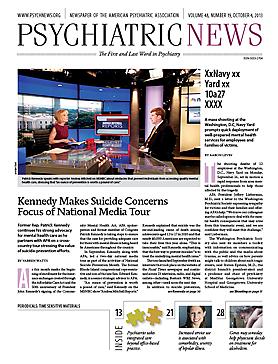From organizations in New Hampshire to state mandates in California, the emphasis on involving patients and their families—alongside physicians—in making the best decisions for treating chronic illness has increased dramatically over the past decade. But is this the best practice for the well-being of patients? According to a study in the September 2 Pediatrics, it is.
Alexander Fiks, M.D., an assistant professor of pediatrics at the University of Pennsylvania, led a study investigating the impact of shared decision making in achieving parental goals for children with attention-deficit/hyperactivity disorder (ADHD).
“National guidelines for pediatrics, and more broadly ‘good clinical practices,’ have stressed the importance of asking families about their preferences and goals for treatment, but that’s not being done consistently,” Fiks told Psychiatric News.
Mark Wolraich, M.D., chief of the Section of Developmental and Behavioral Pediatrics at the University of Oklahoma Health Science Center, agreed. “Making sure to include patients and families in decision making is not a traditional role for clinicians, so it is still not very well done by many clinicians,” he said in an interview.
As chair of the American Academy of Pediatrics (AAP) Clinical Practice Guideline Subcommittee on ADHD, Wolraich stated that the recent AAP toolkit for ADHD treatment—which strongly emphasizes ADHD as a chronic illness that requires shared decision making—included parental representatives from ADHD advocacy groups. He told Psychiatric News that “an important element is educating the patients and their families about ADHD and developing a treatment plan that best meets the patient’s and their family’s needs. The most effective way to do that is with [shared decision making].”
However, evidence to support the claim that shared decision making actually makes a difference in patients with ADHD is lacking, Fiks noted.
In the current study, Fiks and colleagues recruited 148 parents or guardians of children aged 6 to 12 with a diagnosis of ADHD. The children were not receiving combined medication and behavioral therapy at study initiation. To assess preferences and treatment goals, parents and guardians completed an ADHD Preference and Goal Instrument questionnaire at the start of the study and again after six months.
The questionnaire assessed the relationship between baseline treatment preferences and the decision to initiate pharmacological therapy (PT) or behavioral therapy (BT) in an effort to improve academic performance, behavioral compliance, and interpersonal relationships.
At the six-month follow-up, nearly 50 percent of children who were not receiving PT at baseline were taking medication—and 24 percent of those not receiving BT at baseline were being counseled for behavioral issues. The researchers found a correlation between parents whose baseline goals involved improving children’s academic performance and initiation of PT in children, while those whose goals were to improve behavioral compliance and interpersonal relationships were more prone to initiate BT for their children.
At the study endpoint, concerns about academic and behavioral improvement were rated less important by parents whose children initiated PT and BT, suggesting that baseline goals were attained.
“Results suggest that assessing parents’ preferences and goals, as prioritized in the AAP ADHD treatment guidelines, is useful for clinicians in understanding which treatment, if any, parents are likely to initiate for their children,” the authors noted. Fiks added that the study also suggested that inquiring about patients’ preferences and goals for treatment at baseline will help physicians choose a treatment that will promote better patient adherence.
R. Scott Benson, M.D., a child and adolescent psychiatrist and a member of the clinical faculty at Florida State University, said the commitment to assess patients’ and parents’ goals at baseline to increase patience treatment adherence may be ineffective. “We can’t solve this problem with a checklist,” he told Psychiatric News. An avid believer in shared decision making, Benson, who is past speaker of the APA Assembly, stressed that clinicians should provide more information to patients on their disorder and treatment options. “We have to engage parents and children early so that they have a personal investment in their treatment,” he explained. Benson also emphasized that psychiatrists should discuss with patients the time frame often involved in effective psychotherapy. “If it’s not working, discontinue it,” he said.
As for Fiks, he told Psychiatric News that future studies will need to address efficacy of medication dose and frequency of behavioral therapy as it relates to achieving patient treatment goals, in addition to accessing the impact of preferences and goals of children and adolescents on treatment initiation and outcomes.
“ADHD causes a lot of stress and wear on parents who are struggling with treatment decisions. I think that our model initiates a much-needed conversation that rarely happens,” Fiks said.
This study was supported by the National Institutes of Health.


